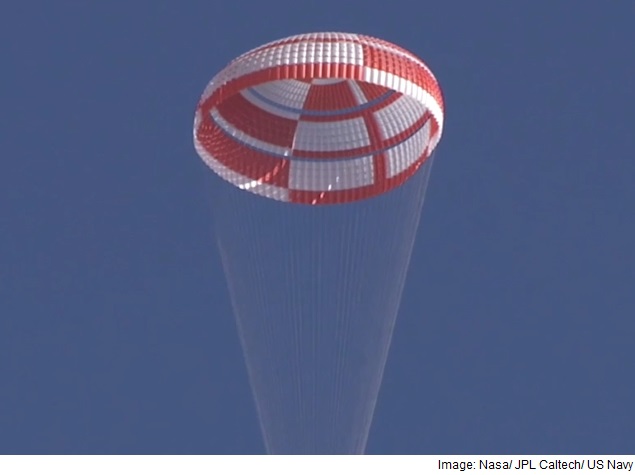- Home
- Science
- Science News
- Nasa to Test Supersonic Parachutes in 'Flying Saucer' Launch
Nasa to Test Supersonic Parachutes in 'Flying Saucer' Launch

The test flight of the flying saucer, known as the Low-Density Supersonic Decelerator, will be broadcast live on Nasa's website beginning at 1:30pm (1730 GMT or 11pm IST).
Since the atmosphere on Mars is so thin, any parachute that helps a heavy, fast-moving spacecraft touch down needs to be extra strong.
The US space agency figured out how to do this decades ago, beginning with the Viking mission which put two landers on Mars in 1976.
But with the goal of sending humans to Mars in the 2030s, the agency is now testing a more advanced, new generation of parachute technology, known as the Supersonic Ringsail Parachute, that could allow even heavier spacecraft - the kind that may have humans and months of food and supplies on board - to land softly.
"We want to see if the chute can successfully deploy and decelerate the test vehicle while it is in supersonic flight," Nasa's Jet Propulsion Laboratory said in a statement.
The test vehicle weighs 6,808 pounds (3,088 kilograms), or about twice the weight of the kind of robotic rover spacecraft Nasa is currently capable of landing safely on Mars.
The parachute, described by Nasa JPL as "the largest parachute ever deployed," is 100 feet (30 metres) in diameter.
The goal is for the chute to "slow the entry vehicle from Mach 2 to subsonic speeds," Nasa said.
The test will involve sending the saucer, an inner-tube shaped decelerator and parachute to an altitude of 120,000 feet (37 kilometres) over the Pacific Ocean with the help of a giant balloon.
The balloon will release the spacecraft and rockets will lift the vehicle even higher, to 180,000 feet (55 kilometres), reaching supersonic speeds.
"Traveling at three times the speed of sound, the saucer's decelerator will inflate, slowing the vehicle, and then a parachute will deploy at 2.35 times the speed of sound to carry it to the ocean's surface," Nasa said.
The first test flight of the flying saucer was in June 2014, and another test flight is planned in 2016.
For the latest tech news and reviews, follow Gadgets 360 on X, Facebook, WhatsApp, Threads and Google News. For the latest videos on gadgets and tech, subscribe to our YouTube channel. If you want to know everything about top influencers, follow our in-house Who'sThat360 on Instagram and YouTube.
Related Stories
- Galaxy S24 Series
- MWC 2024
- Apple Vision Pro
- Oneplus 12
- iPhone 14
- Apple iPhone 15
- OnePlus Nord CE 3 Lite 5G
- iPhone 13
- Xiaomi 14 Pro
- Oppo Find N3
- Tecno Spark Go (2023)
- Realme V30
- Best Phones Under 25000
- Samsung Galaxy S24 Series
- Cryptocurrency
- iQoo 12
- Samsung Galaxy S24 Ultra
- Giottus
- Samsung Galaxy Z Flip 5
- Apple 'Scary Fast'
- Housefull 5
- GoPro Hero 12 Black Review
- Invincible Season 2
- JioGlass
- HD Ready TV
- Laptop Under 50000
- Smartwatch Under 10000
- Latest Mobile Phones
- Compare Phones
- Huawei Pura 70 Pro+
- Huawei Pura 70 Ultra
- Tecno Camon 30 Premier 5G
- Motorola Edge 50 Fusion
- Oppo A1i
- Oppo A1s
- Motorola Edge 50 Ultra
- Leica Leitz Phone 3
- Asus ZenBook Duo 2024 (UX8406)
- Dell Inspiron 14 Plus
- Realme Pad 2 Wi-Fi
- Redmi Pad Pro
- Cult Shock X
- Fire-Boltt Oracle
- Samsung Samsung Neo QLED 8K Smart TV QN800D
- Samsung Neo QLED 4K Smart TV (QN90D)
- Sony PlayStation 5 Slim Digital Edition
- Sony PlayStation 5 Slim
- IFB 2 Ton 3 Star Inverter Split AC (CI2432C323G1)
- Daikin 1 Ton 3 Star Inverter Split AC (FTKL35UV16W+RKL35UV16W)
-
 Snapchat to Display Watermark on Images Created Using Snap's Generative AI Tools
Snapchat to Display Watermark on Images Created Using Snap's Generative AI Tools
-
 Wayve Lingo-2 AI Model With Autonomous Driving Capabilities, Ability to Take Passenger Instructions Showcased
Wayve Lingo-2 AI Model With Autonomous Driving Capabilities, Ability to Take Passenger Instructions Showcased
-
 Redmi 13 5G Model Numbers Surface Online; Could Debut in India as Poco M7 Pro 5G
Redmi 13 5G Model Numbers Surface Online; Could Debut in India as Poco M7 Pro 5G
-
 Moto Buds, Moto Buds+ With Dynamic ANC, Hi-Res Audio Launched: Price, Specifications
Moto Buds, Moto Buds+ With Dynamic ANC, Hi-Res Audio Launched: Price, Specifications












